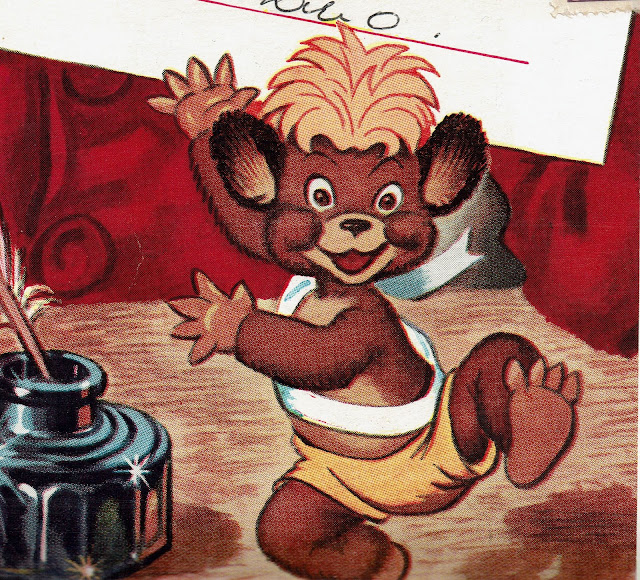 |
| A creation of famed Canadian cartoonist Charles Thorson, Punkinhead the bear was a common sight inside and around Eaton's department store. |
Bright colours and holiday festivities roared down the Toronto streets last week for the 2024 edition of The Original Santa Claus Parade provided a delightful spectacle for young people as well as those people young at heart. Part of the parade’s draw to audiences during this seasonal tradition is the appearance of whimsical characters. Of course, Santa Claus and more recently Mrs. Claus is lead figures of the holiday parade while other staples of the pre-Christmas event include marching bands as well as the Celebrity Clowns. Modern editions of The Original Santa Claus Parade have also involved a number of popular characters familiar to audiences beyond the parade. Former Canadian department store Eaton, the originator and longtime sponsor of the Toronto Santa Claus Parade, chose in 1947 to introduce a new mascot to appeal to toy-craving children. Punkinhead arrived as a friendly faced bear accompanied by a charming tale made by Canadians to delight Canadians.
The source of life for Punkinhead came from the imagination of famed Manitoba-born cartoonist Charles Thorson. Though the 1930s, Thorson’s talents provided contributions to animated motion pictures including participation with the Walt Disney Company on Snow White and the Seven Dwarfs. While working with Warner Brothers, the Canadian would gain credit for his role creating the likeness for Bugs Bunny. Punkinhead, a name given by Thorson previously attached as a playful nickname for his son, came to life as a bear distinguished for his head of messy blond hair. Following the creation of the character, Thorson turned over the rights of Punkinhead to Eaton for a token $1 amount.
 |
| Large Punkinhead inside Eaton's Winnipeg store in the 1950s. Image from Eaton's Contacts employees newsletter. |
The successful marketing Punkinhead appearance in the Eaton’s Santa Claus Parade would involve his own elaborate float through the 1950s and 1960s. Examples of float designs include one in 1954 where the bear rode a rocket as well the 1960 parade featuring Punkinhead serving as a special passenger on the colourful Candyland Express train. Additionally, Punkinhead’s celebrity among younger audiences stretched across Canada. Beside being a staple for Christmas celebrations, the cuddly bear found a place in other major festivities at Eaton stores. Eaton’s Big Week promotion in 1954 at the Winnipeg store had Punkinhead joined by other players in a puppet show.
The Eaton department store chain accompanied the character’s appearance in the holiday tradition with a series of children’s books. The first story of Punkinhead was distributed in 1948 titled The Sad Little Bear. His back story was described as a resident of a mythical Bear-Land who rose to an occasion to replace a clown to participate in the Eaton’s Santa Claus Parade. Punkinhead’s head of blond hair proved fortuitous for assuming the prized role. For every year until 1961, a new Punkinhead would be published and distributed by Eaton’s resulting in a total of 13 books around the Canadian-created fictional bear. Passing along the cheery, upbeat stories proved so important to store staff. The July 1955 issue of Contacts (a newsletter that was published for Eaton employees) documents how an Eaton driver brought a Punkinhead book to a child after the customer mentioned her daughter was sick and unable to visit Santa Claus.
 |
| Punkinhead sitting beside Santa Claus. Image from 1950s era pamphlet distributed to children. |
Beyond books, Punkinhead’s image was also spread across a wide range of merchandise found in Eaton’s toyland. One of the more popular expansion of Punkinhead appeared in stuffed bears originally manufactured by the Merrythought Toy Company. At this time, those classic Punkinhead stuffed toys can now fetch up to $3,000 in the collector market. The Eaton store also sold a great deal of other items branded with their bear mascot frequently through the 1950s and 1960s.
Before his passing in 1966, Charles Thorson styled one more Canadian icon. Elmer the Safety Elephant was spearheaded by Toronto mayor Robert Hood Saunders in efforts to replicate a children safety initiative in Detroit. Toronto Police officer Vernon Page, an active traffic safety advocate in the department, championed the choice of an elephant While the campaign launched in 1947 through an association between the Toronto Police and the Toronto Evening Telegram, Thorson was brought in to give Elmer an imaging to make him better appear to younger children that was introduced in 1948. The revised Elmer the Safety Elephant has since rose to become a national figure educating younger Canadians about safety fundamentals.
With the final book based on the Punkinhead published in 1961, Eaton continued to feature the bear on products into the 1970s. An updated line of Punkinhead products would be released in the 1990s as a nostalgic call-back ahead of the department store’s 125th anniversary.
 |
| A Christmas 1993 Eaton mini catalog featured an updated Punkinhead on the cover being held of a young girl. The 1993 edition of Punkinhead wore a sweater and came with a mini book. |
Distressingly enough, despite the impact Punkinhead had with the children of his original era, Eaton would apparently start losing the audience as customers as they advanced to adulthood. The downfall of the department store occurred through the 1970s into the 1990s eventually leading to its bankruptcy in 1999. Punkinhead remains a fondly remembered example of what happens when a prominent Canadian business and Canadian cartoonist put together a charming childhood character.


Comments
Post a Comment